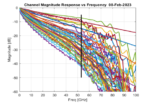You are currently viewing SemiWiki as a guest which gives you limited access to the site. To view blog comments and experience other SemiWiki features you must be a registered member. Registration is fast, simple, and absolutely free so please,
join our community today!
Next generation semiconductor design puts new stress on traditionally low-key parts of the design process. One example is packaging, which used to be the clean-up spot at the end of the design. Thanks to chiplet-based design, package engineers are now rock stars. Analog design is another one of those disciplines.
Not long ago,… Read More
Digital logic chips synchronize all logic operations by using a clock signal connected to flip-flops or latches, and the clock is distributed across the entire chip. The ultimate goal is to have a clock signal that arrives at the exact same moment in time at all clocked elements. If the clock arrives too early or too late from the PLL… Read More
The increasing demands for massive amounts of data are driving high-performance computing (HPC) to advance the pace in the High-speed Ethernet world. This in turn, is increasing the levels of complexity when designing networking SoCs like switches, retimers, and pluggable modules. This growth is accelerating the need for … Read More
SOCs designed on advanced FinFET nodes like 7, 5 and 3nm call for silicon-validated physical analog IP for many critical functions. Analog blocks have always been node and process specific and their development has always been a challenge for SOC teams. Fortunately, there are well established and endorsed analog IP companies… Read More
At the recent ISSCC conference, Mozhgan Mansuri from Intel gave an enlightening (extended) short course presentation on all thing related to clocking, for both wireline and wireless interface design. [1] The presentation was extremely thorough, ranging from a review of basic clocking principles to unique circuit design … Read More
TSMC’s Open Innovation Platform’s main objective is to create and promote partnership for producing chips. This year’s OIP event included a presentation on the joint efforts of Silicon Creations, Mentor, a Siemens business and TSMC to produce essential PLL IP for 5nm and 3nm designs. The relentless push for smaller geometries… Read More
A Phase-Locked Loop (PLL) gives design a heartbeat. Despite its minute footprint, it has many purposes such as being part of the clock generation circuits, on-chip digital temperature sensor, process control monitoring in the scribe-line or as baseline circuitry to facilitate an effective measurement of the design’s power… Read More
Most people think that designing successful high speed analog circuits requires a mixture of magic, skill and lots of hard work. While this might be true, in reality it also requires a large dose of collaboration among each of the members of the design, tool and fabrication panoply. This point was recently made abundantly clear … Read More
Jitter issues in SOC’s reside at the crossroads of analog and digital design. Digital designers would prefer to live in a world of clocks that are free from jitter effects. At the same time, analog designers can build PLL’s that are precise and finely tuned. However, when a perfectly working PLL is inserted into an SOC, things can … Read More
Well it comes as no surprise to those that use and design them, that PLL’s are a world unto themselves and very complicated indeed. With PLL’s we are talking about analog designs that rely on ring oscillators or LC tanks. They are needed on legacy nodes, like the ones that IoT chips are based on, and they are crucial for high speed advanced… Read More








